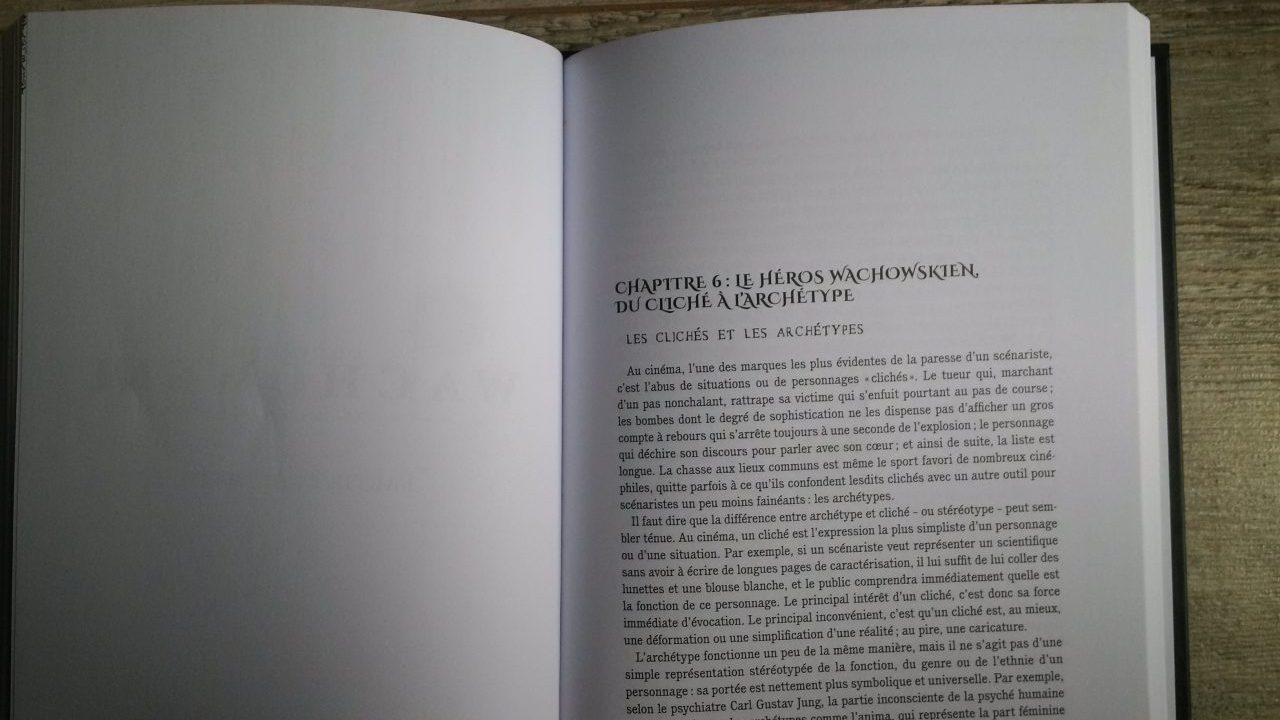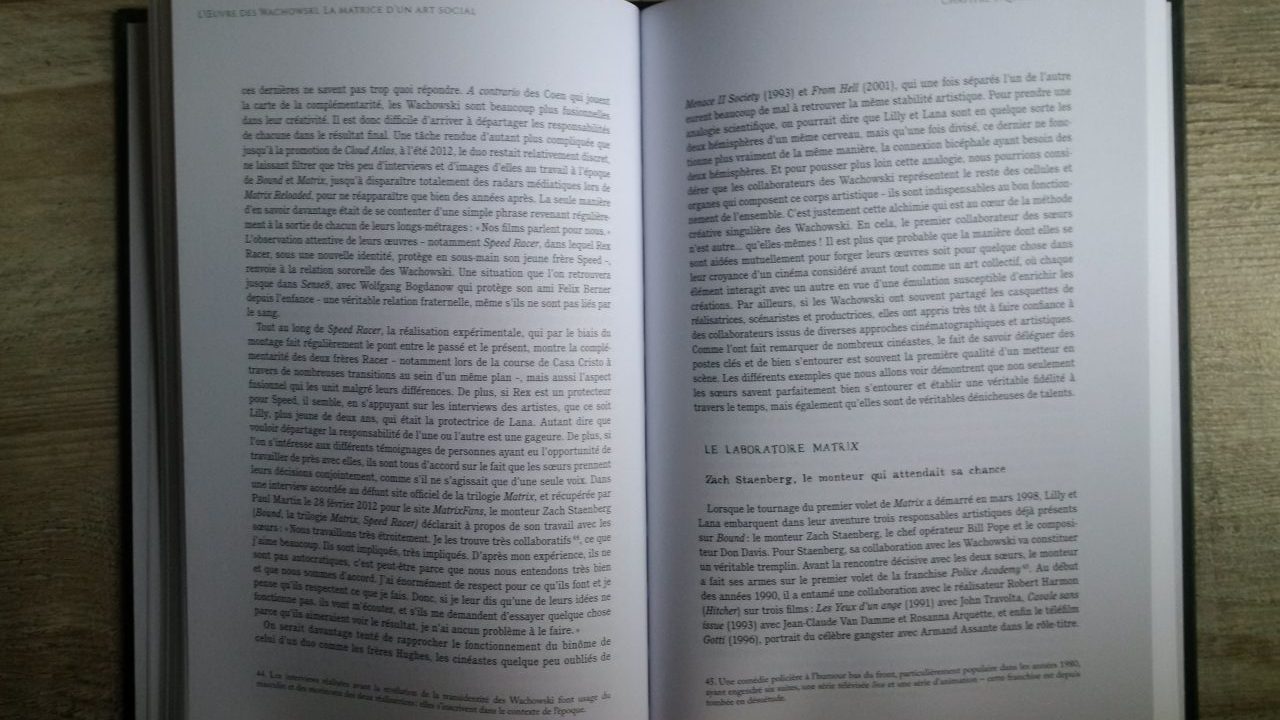After plunging into the matrix of Ghost In The Shell, we start the year 2022 with the book published by Third Editions, The Work of the Wachowskis – The matrix of a social art. The opportunity to discover the rich and fascinating filmography of the filmmakers, some time after the cinema release of the mixed Matrix Resurrections, pseudo sequel to the trilogy. Without forgetting the release of the free demo on next gen console, Tea Matrix Awakens.
The book is written by Julien Pavageau, Aurélien Nover and Yoan Orszulik from the YouTube channel Mr. Bobine’s Cine Club. A very interesting and relevant channel that we recommend, especially if you are passionate about cinema.
A Wachowskian universe
As often in Third Edition books, The Work of the Wachowskis – The Matrix of a Social Art will return to the careers of the filmmakers, in order to enlighten us on their visions of the world and of cinema. But also bring some context to the situations exposed, as well as bring some thoughtful, documented reflections and analyzes about the various films that make up the Wachowski filmography. From their first feature film, Bound (1996) until Sense8 (2015-2018), Passing by Speed Racer (2008), etc The book will be divided into two main parts.
A first dedicated to aesthetics in the broad sense, by returning to the influences present in the filmography of the filmmakers, but also their relationship to cultures and beliefs, without forgetting the phenomena of resonances. That is to say the elements that can be found in several artistic creations, by various authors, which respond to each other through links of influence, themes, or even on reflections and/or a particular vision of the world. . And this, without there being necessarily direct, or even conscious inspiration. For example, we can cite the use of Bullet-Time in the 90s. Whether in Matrix in 1999, in Blade (1998) or just in games Max Payne. If the first title of the license born by Remedy studios was only released in 2001, the genesis of the video game project dates back to 1996 and Bullet-Time was already in everyone’s mind. Indeed, this slow motion process was initially popularized by the filmmaker John Woo in movies like The Crime Syndicate (1986) or The Killer (1989), among others, which are real successes and important works of cinema.
As for the second part of the book, it will be about social art. In other words, the authors will be interested in the people who gravitate around the sisters. A family of important and recurring collaborators who will participate in giving an identity to the cinema of the two sisters, Lana and Lilly. Thanks to their analyzes and relying on specific sources, the authors of M. Bobine’s film club will also highlight the propensity of filmmakers to want to fully involve the spectators in their works. With the aim of creating meaning and emotion, bringing real sensations to the public, without lowering the quality of the aesthetic level of their films. In addition to systematically encouraging the public to think about the world around them and what they see on the screen.
Indie Blockbuster

The book will also highlight a number of useful elements for understanding a rich and often complex filmography to assimilate. There is, for example, in one of the chapters, a whole segment on the use of stereotypical characters by the Wachowskis. The latter use clichés to win the support of the public, but quickly manage to ensure that their characters free themselves from these stereotypes, without all this impacting the suspension of disbelief necessary for involvement in a film universe. This capacity that filmmakers have is thus very well explained in the Third Editions book. Bringing meaning and interest to certain facts and elements, which rarely leave room for chance.
The Work of the Wachowskis – The Matrix of a Social Art therefore has the major interest of offering weapons of understanding to readers vis-à-vis the abundant filmography of filmmakers. Whether it be Matrix, Speed Racer Where CloudAtlas, questions of taste will have no place, several cinematographic experiments are at work in these films, and many diverse and varied influences come together in them. This is what will interest the authors. Moreover, the density of information, symbolism and references in the films of Lana and Lilly Wachowski contribute to making them complex to apprehend, difficult to define. The work carried out by the film club of M. Bobine makes it possible to better grasp this richness, to obtain new keys to reading and interpretation. Just the accumulation of influences referred to in the book is fascinating as they are abundant and heterogeneous.
For the form, Third Editions requires, the book does not bother visual. The aesthetic part is only there for the front cover, successful as always. But the publishing house is above all renowned for the quality of its products and the ability of the authors to manage to make the readings fluid, with well-arranged chapters. Whether or not you are a connoisseur of the universe of the two sisters or of cinema, it is quite possible to appreciate The Work of the Wachowskis – The matrix of a social art.
Should we fall for The Work of the Wachowskis – The matrix of a social art?

Logically, the book by Julien Pavageau, Aurélien Nover and Yoan Orszulik is above all aimed at moviegoers and other enthusiasts of the Wachowskis’ work or even simply of the trilogy. Matrix, which logically enjoys a little more presence in the book. As the front cover might suggest. However, the authors skillfully multiply the links from one creation to another, which allows them to dwell properly on the entire filmography. Same V for Vendetta will be addressed. Although it is not directed by the sisters, the director at the wand is a close collaborator of the latter, without forgetting that they are the ones who officiate as screenwriters, in addition to finding many of their entourage on the set. An opportunity to mention Lana and Lilly’s approach to culture and art in general, which they see as a network where all the elements can connect with each other, without any hierarchy. A system called Rhizome and developed by philosophers Gilles Deleuze and Félix Guattari. The Matrix symbolize this system very well, and the work of the Wachowskis in general.
If some still doubted it, The Work of the Wachowskis – The Matrix of a Social Art shows the uniqueness of the filmmakers, their cinema and their vision as well. The authors also see a possible comparison with the dominant vision in the work of Hideo Kojima. Indeed, in the same way as the Wachowskis, the father of Metal Gear Solid generally seeks to combine a discourse, to make us think about the medium itself while coating everything with a playful aspect. What Lana and Lilly do by systematically seeking the emotion and the involvement of the spectators, spectators in their cinema. But one of the greatest strengths of filmmakers is to succeed in creating rich cocktails of experimentation and influences that are totally digestible and affordable. That is why Matrix, especially the first opus, symbolizes an entire era and has managed to become a kind of blockbuster in its own right by upsetting the way of making films for the general public. Then becoming a historical marker in the history of cinema, and in the lives of many people. There was a before and an after Matrix.
Buy The Work of the Wachowskis – The Matrix of a Social Art on Amazon
If you are a fan of cinema, of Lana and Lilly, or simply of one of their creations, then don’t hesitate to get L’Work of the Wachowskis – The matrix of a social art. You will definitely learn things.
